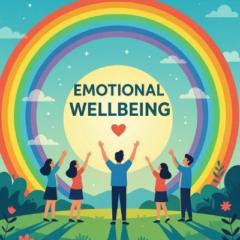4d (edited) • General discussion
The Profound Impact of Thoughts: Unpacking the Mind-Body Connection
The idea that "every thought you think causes a physical reaction and an emotional response within you" isn't just motivational rhetoric—it's grounded in decades of research in psychology, neuroscience, and psychophysiology. Thoughts are far from abstract; they are dynamic forces that shape our biology and emotions in real time. Let's expand on this, exploring the science, real-world examples, and practical applications to empower you in your journey toward greater emotional health.
The Science Behind the Mind-Body Connection
At its core, the mind-body connection refers to the intricate interplay between our cognitive processes (thoughts), emotional states, and physical body. This isn't woo-woo philosophy; it's backed by fields like psychoneuroimmunology, which studies how psychological factors influence the nervous and immune systems.
Neurological Responses: When you have a thought, it activates specific neural pathways in your brain. For instance, the amygdala (our emotional alarm system) and the prefrontal cortex (involved in reasoning) light up. This triggers the release of neurotransmitters like dopamine, serotonin, or norepinephrine, which directly influence your mood and energy levels.
Hormonal Cascades: Thoughts stimulate the hypothalamic-pituitary-adrenal (HPA) axis, our body's stress response system. A single negative thought can prompt the release of cortisol (the stress hormone), leading to physical changes such as elevated blood pressure or muscle tension. Conversely, positive or affirming thoughts can boost oxytocin (the "bonding hormone") or endorphins (natural painkillers), promoting relaxation and joy.
Autonomic Nervous System Involvement: Your thoughts engage the sympathetic (fight-or-flight) or parasympathetic (rest-and-digest) branches of the nervous system. A fearful thought might accelerate your heart rate and shallow your breathing, preparing your body for perceived danger. A grateful thought, however, can slow your pulse and deepen respiration, fostering a state of calm.
This bidirectional link means that not only do thoughts affect the body, but physical sensations can loop back to influence thoughts—creating a feedback cycle that can either uplift or undermine your wellbeing.
Real-Life Examples: From Stress to Serenity
To make this tangible, consider how everyday thoughts manifest physically and emotionally:
Stressful Thoughts in Action: Imagine dwelling on a work deadline: "I'm going to fail at this." This rumination can spike adrenaline, causing your heart to race, palms to sweat, and muscles to tense—classic signs of anxiety. Emotionally, it might breed frustration or hopelessness. Over time, chronic stressful thinking contributes to issues like insomnia, weakened immunity, or even digestive problems, as seen in studies on chronic stress and gut health.
Calming Thoughts as a Counterbalance: Now, shift to a positive reframing: "I've overcome challenges before; I can handle this." This thought can release endorphins and serotonin, lowering your heart rate, easing tension, and evoking feelings of confidence and peace. Research from positive psychology, including work by Barbara Fredrickson on the "broaden-and-build" theory, shows how such thoughts expand our emotional resilience and even enhance creativity.
These reactions happen instantaneously, often below conscious awareness, which is why mindfulness practices are so transformative—they help us catch and redirect thoughts before they snowball.
Implications for Emotional Wellbeing
Understanding this connection is a game-changer for emotional health. It empowers us to see thoughts not as uncontrollable intruders but as malleable tools. In our Skool community, this means recognising that poor emotional states aren't just "in your head"—they have real physiological roots and consequences. For example:
Mental Health Conditions: Conditions like depression or anxiety often involve thought patterns (e.g., catastrophic thinking) that perpetuate physical symptoms, such as fatigue or headaches. Therapies like Cognitive Behavioural Therapy (CBT) target this by rewiring thoughts to break the cycle.
Long-Term Health Effects: Persistent negative thinking can lead to inflammation, cardiovascular strain, or weakened immune function, increasing risks for illnesses. On the flip side, cultivating optimistic thoughts correlates with better recovery from surgery, stronger relationships, and even longer lifespans, as evidenced by longitudinal studies like the Nun Study on aging and mindset.
By embracing this, we shift from reactive to proactive emotional management, fostering a holistic sense of wellbeing.
Practical Strategies to Harness This Power
As a trainer, I always emphasise actionable steps. Here's how you can apply this in daily life:
1. Thought Awareness Exercises: Start with a simple journaling practice. Track a thought, note its physical (e.g., "tight chest") and emotional (e.g., "anxious") effects, then reframe it. Apps like Headspace or Insight Timer can guide you.
2. Mindfulness and Meditation: Techniques like body scans help you observe the mind-body link without judgment. Even 5 minutes a day can reduce cortisol levels and enhance endorphin production.
3. Cognitive Reframing: Challenge distortions—turn "This is a disaster" into "This is a challenge I can learn from." Over time, this builds neural pathways for positivity.
4. Physical Interventions to Influence Thoughts: Since the connection is two-way, use exercise, deep breathing, or progressive muscle relaxation to calm the body, which in turn quiets the mind.
5. Community Support: In our Skool group, share your experiences! Discussing thoughts collectively normalises them and provides fresh perspectives to reframe.
Remember, change takes practice—be patient with yourself as you build these habits.
Empower Your Inner World
In essence, every thought is a ripple that echoes through your body and emotions, illustrating the profound mind-body connection. As we explore this in our emotional wellbeing community, let's commit to nurturing thoughts that heal rather than harm. You're not just thinking—you're shaping your reality. If this resonates, drop your thoughts in the comments below; I'd love to hear how you're applying it!
0
0 comments
powered by

skool.com/emotional-wellbeing-service-1635
How to Achieve Emotional Balance and Harmony that strengthens your resilience and moves you forward from a place of surviving to thriving.
Suggested communities
Powered by
